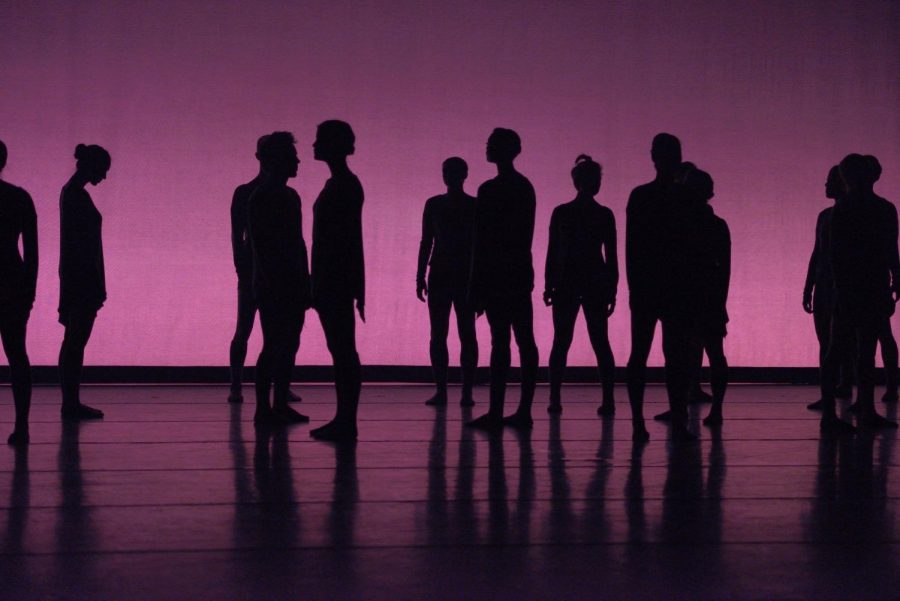Hibben: The U’s Ballet Program Perpetuates Toxic Ballet Culture
Students from the Utah Ballet Department perform in a dress rehearsel in the Marriot Center for Dance on campus on Wednesday, Nov. 4, 2015.
December 2, 2021
In September 2021, the NPR Utah published an exposé about the University of Utah’s Marriott School of Dance. The letter detailed complaints of harassment, discrimination and authoritarian attitudes from former faculty and students. Alumni wrote a long list of suggestions to improve upon, and the School of Dance vowed to do so. However, students have indicated that these improvements haven’t been made and that the issues the program suffers from are ingrained in ballet culture.
For anyone with ballet experience, these allegations aren’t surprising. As a former ballet dancer and student in the U’s ballet program, I have the same concerns that alumni reported. College ballet programs should cultivate positive experiences, rather than those of mistreatment. They should provide supportive environments for dancers to train and learn. Unfortunately, the leaders of the U’s ballet program have let ballet’s toxic culture perpetuate a supposed learning environment.
The Pressure from Teachers
From a young age, dancers learn the importance of discipline. A teacher’s attention is so desired that dancers often ignore any harassment or discrimination. Your worst nightmare is a teacher’s disapproval.
I once had a teacher who nicknamed me “bird legs,” and I didn’t say anything because she controlled all casting for performances and my training. Ballet’s intense issues with giving teachers enormous power allow for the mistreatment of students to continue, and the U’s dancers are no exception to this practice.
In an interview with an anonymous student in the ballet program, they noted that reports of an authoritative power structure were true. They said, “Teachers grade you on their opinion … If you have an injury or don’t dance in the way that this certain professor really likes, it’s hard to get good grades.”
Allowing grades and casting to hinge on teachers’ opinions creates a system of unbalanced power — one that allows mistreatment to continue. When talking about the new anonymous reporting site, the anonymous dancer explained, “I still feel like that is not a very useful tool. It just seems like an empty offer.”
Even if students report incidents, the letter didn’t include plans to address these concerns with faculty. “It’s hard to report an incident with a faculty member because when you bring it up,” the dancer said, “you get brushed off their shoulder. It’s discouraging and doesn’t compel students to come forward.”
Toxic Ballet Culture
The pressure to have a perfect “ballet body” directly contributes to rampant body dysmorphia and eating disorders. Long legs, hyperextended knees, small waists and other physical attributes are highly desirable traits for ballerinas that are nearly impossible to attain if you aren’t born with them. The students used in promotional materials generally fit that strict ballet mold, projecting an image to the entire school that these are the dancers they choose to highlight.
Despite these impossible standards, former dancers at the U reported that their “grades were a reflection more of your size” and that professors suggested students lose weight. I also noticed this harassment in my classes. Professors preferred students with the “ballet body” both in class and on casting lists.
Additionally, former students described the racial bias they faced in the U’s program. In my freshman year, we had a guest lecturer tell us to raise our hands if he mentioned our race, only to ignore those of mixed race. While he meant to speak on improving diversity in the program, he managed to make many dancers feel uncomfortable and out of place. This experience, and the general lack of diversity at the U’s dance program, showed me that the faculty’s response is simply performative.
Injuries are also commonplace in ballet, and yet almost every ballet dancer I have met has either hid or self-medicated an injury for fear of teachers labeling them as problematic. The anonymous dancer said, “Students were afraid of getting bad grades or not being able to get the credit, so they just danced. As athletes, we need to be taking care of our bodies and when we’re afraid to actually do that, it’s really harmful.”
A Pathway for Change
These issues only scratch the surface of the harmful effects teachers have on dancers. As of now, professors in the ballet program have no accountability system in place, unlike any academic department at the U. They don’t need to explain why they cast certain dancers in lead roles, and others on the sidelines. And if shows don’t cast you, your grades suffer, which only exacerbates these problems.
The school needs to drastically change its approach to teaching ballet. This culture won’t disappear with a few pieces of training and surveying students — it will take a complete overhaul of this authoritarian system.
Students should also be allowed time, not penalized, for injuries, including mental health concerns. The grading system should involve less of a teacher’s opinion and more of effort, regardless of size or race. The anonymous dancer suggested having a mental health professional in the dance building and having a student liaison to advocate for students and provide better pathways to reporting incidents with teachers.
While I adore ballet, it’s a highly glamorized art that hides a lot of problems. The moment I put on a sparkly tutu and heard the roar of an audience, I forgot the teacher who slapped my stomach every day and said “I can see your lunch”, or the multiple injuries I hid for fear of being “unusable.”
My romance with ballet ended with physical and mental pain because of systemic issues enforced by ballet teachers. The art of ballet, while highly athletic, serves as an outlet to express emotion. The U’s ballet program has failed its students because it forgot that anyone can be a ballet dancer.












A. J. Smith • Mar 28, 2022 at 8:20 pm
Great article. As a board member for a new professional ballet company born specifically to reject the toxicity surrounding a beautiful art form, I continue to be heartbroken by how pervasive this problem is. We are breaking the cycle at Confluence Ballet. Be well.